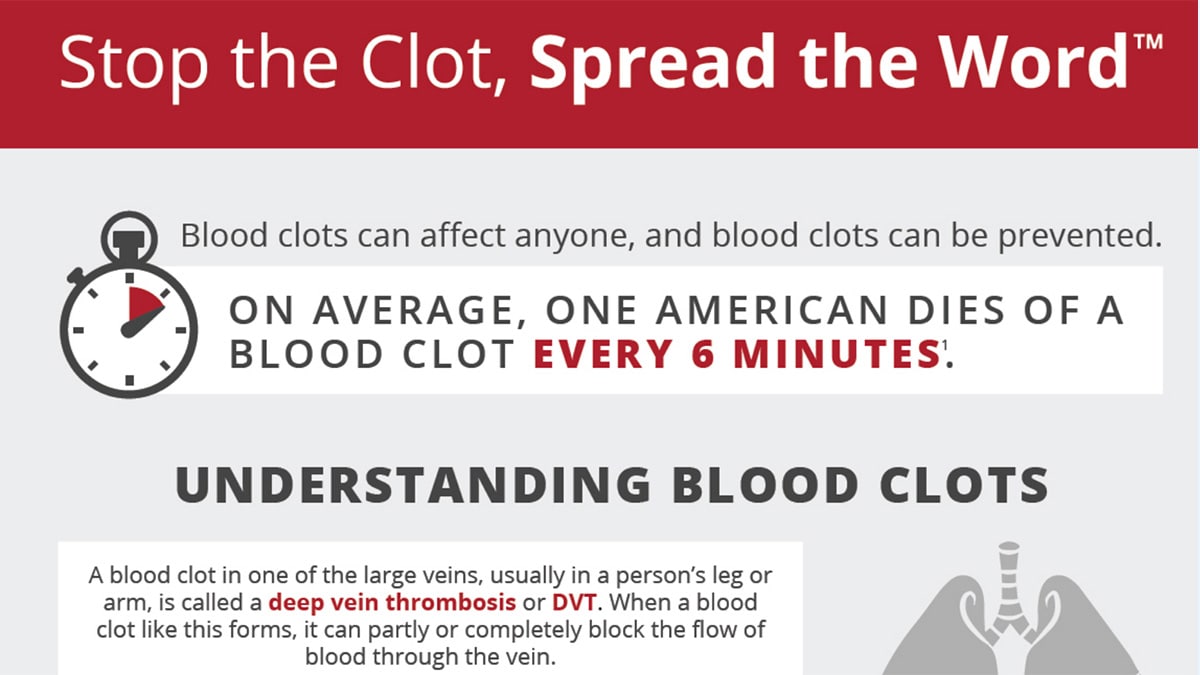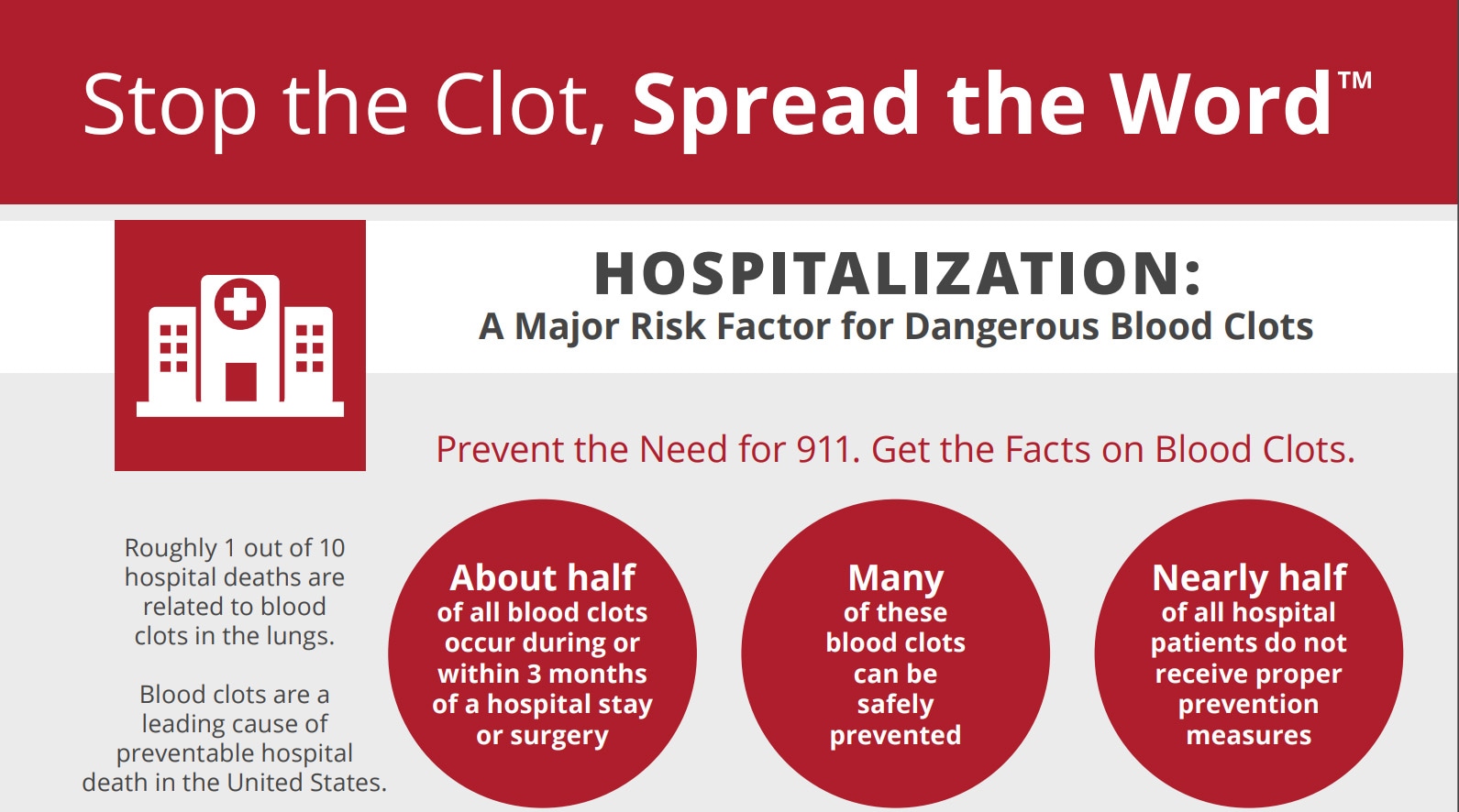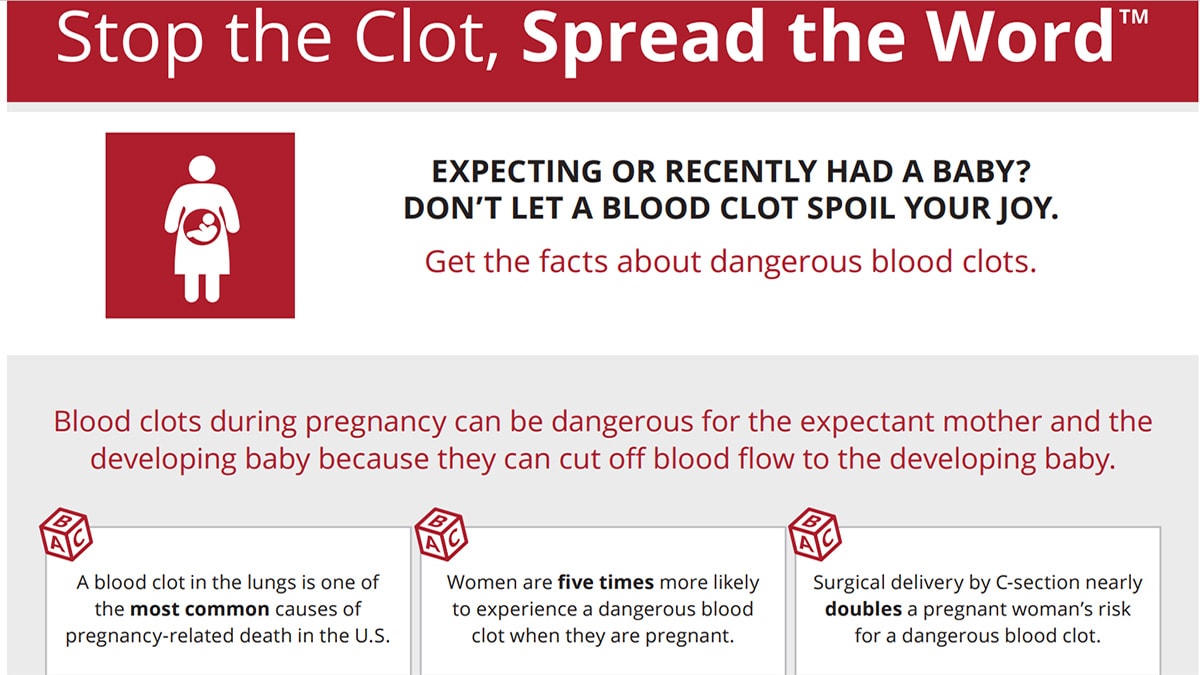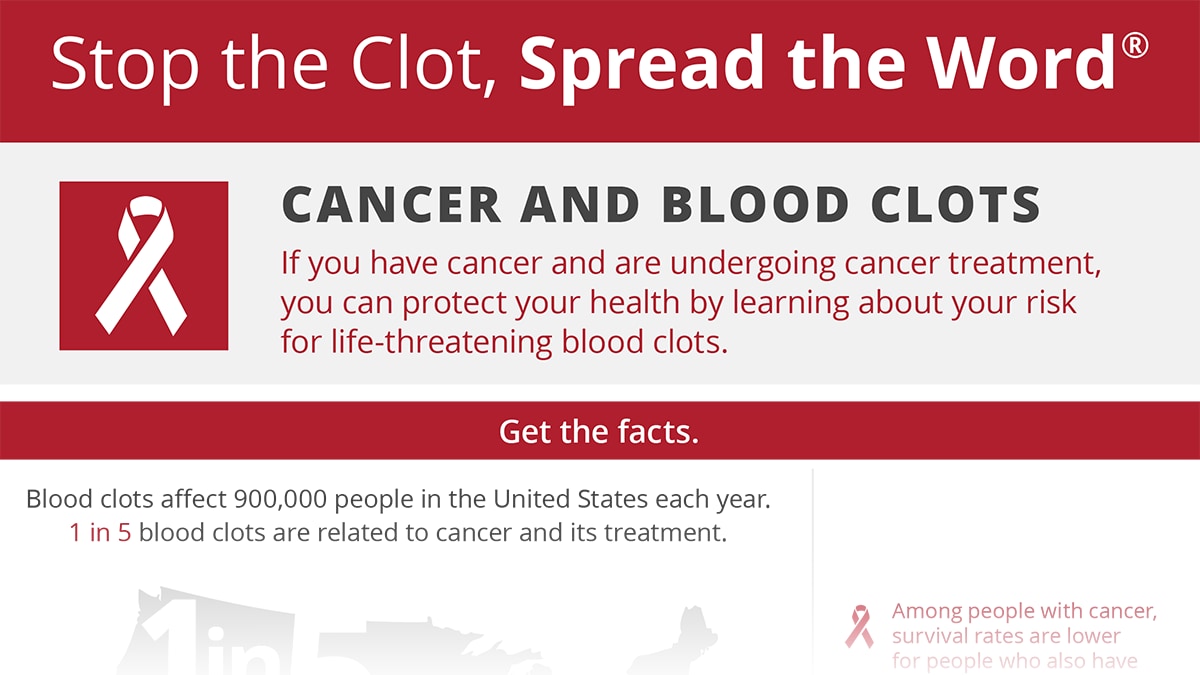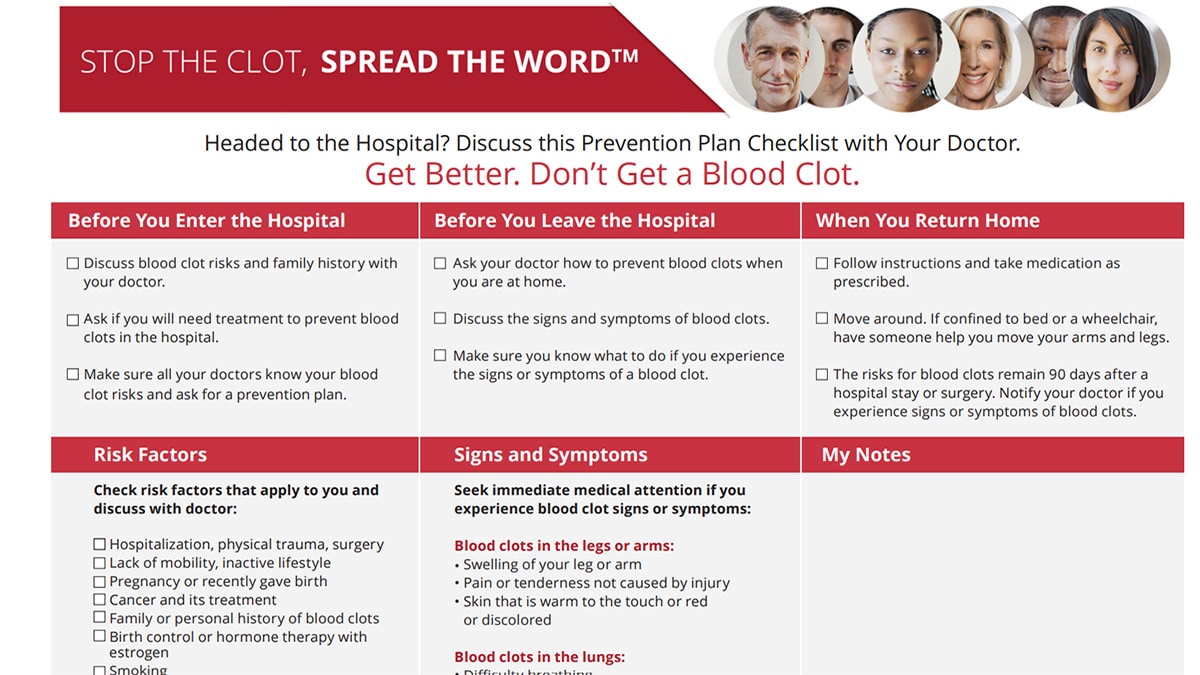What to know
Help us spread the word! This resource toolkit is a collection of campaign resources that provides important information about signs and symptoms of blood clots, as well as factors that increase the chance of developing blood clots. The following resources are included for sharing with friends and family or in newsletters or other publications.
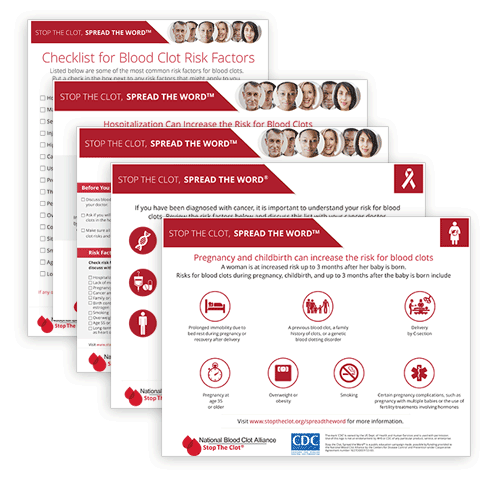
Overview
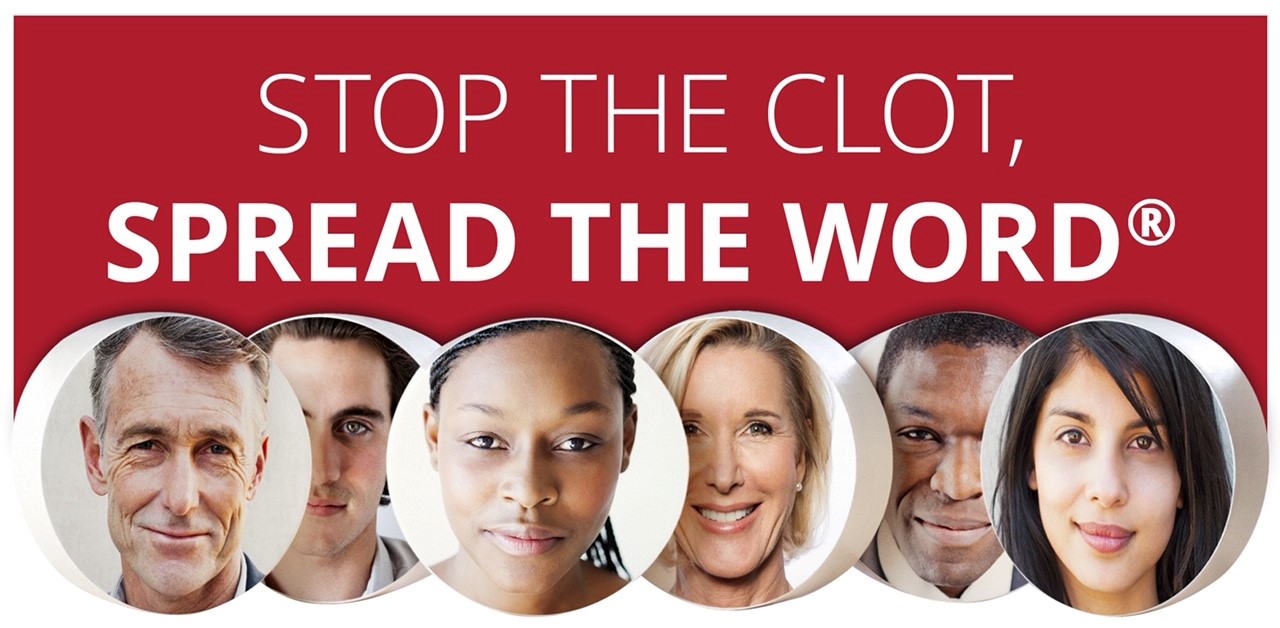
Stop the Clot, Spread the Word® campaign
Blood clots are often an under-diagnosed medical condition.
It is important to know about blood clots because they can happen to anybody and can cause serious illness, disability (sickness, illness), and in some cases, death. The good news is that blood clots are preventable and treatable if discovered early.
Learning the signs, symptoms, and risks for blood clots can save lives! Spread the word by sharing the resources in this new resource toolkit for the Stop the Clot, Spread the Word® campaign.
Learning and recognizing the signs and symptoms of blood clots can save lives. The Stop the Clot, Spread the Word® campaign is a public health education campaign developed by the National Blood Clot Alliance in collaboration with CDC from 2015 through 2019. This digital, multimedia public health awareness campaign provides general information about the risks, signs, and symptoms of blood clots and the important steps to take to prevent them.
The campaign also provides tailored information for three groups at greater risk for developing a blood clot:
- People recently hospitalized
- Women who are expecting or recently had a baby
- People being treated for cancer
Stop the Clot, Spread the Word® campaign resources to share
Videos
View the video below to learn general information about blood clots.
View the video below to learn more about blood clots and hospitalization.
View the video below to learn more about blood clots and pregnancy.
View the video below to learn more about blood clots and cancer.
Public service announcement video
View the public service announcement video below to learn more about the signs, symptoms, and factors that increase risks for blood clots.
Infographics
Downloadable checklists
Audio news releases
Learn more about blood clots by listening to national experts.
Blood Clots and Hospitalization
Gregory A. Maynard, MD, MS, MHM, Chief Quality Officer, UC Davis Medical Center
Download and listen to media [MP3 – 983 KB]
Blood Clots and Pregnancy
Andra H. James, MD, MPH, Consulting Professor Obstetrics & Gynecology, Division of Maternal-Fetal Medicine, Duke Medicine
Download and listen to media [MP3 – 988 KB]
Blood Clots and Cancer
Alok A. Khorana, MD, Professor of Medicine, Cleveland Clinic Lerner College of Medicine, Case Western Reserve University, the Sondra and Stephen Hardis Chair in Oncology Research, Vice-Chair for Clinical Services of the Taussig Cancer Institute; Director of the Gastrointestinal Malignancies Program at the Cleveland Clinic
Download and listen to media [MP3 – 1 MB]
Social media
Here are examples of social media posts you can use to share the contents of this resource toolkit on blood clots. Share information and help increase awareness about blood clots:
X (formerly known as Twitter) sample messages in English
- Think blood clots can't happen to you? Think again. Blood clots affect more than 900,000 people each year and ~100,000 die from them. The good news: #BloodClots can be prevented or treated. Learn the signs, symptoms, and how to protect your health: http://bit.ly/2PAeHNO #StoptheClot
- Blood clots can happen to anyone, but a family history of blood clots, hospitalization, pregnancy, or cancer treatment can indicate a higher risk. A resource toolkit from the Stop the Clot, Spread the Word® breaks down the facts: http://bit.ly/2PAeHNO #StopTheClot
X (formerly known as Twitter) sample messages in Spanish
- ¿Piensas que no te pueden aparecer #CoágulosDeSangre? Piensa en esto: afectan a más de 900 000 personas al año y unas 100 000 mueren. Lo bueno: se pueden prevenir o tratar. Aprende los signos, síntomas, y cómo proteger tu salud: https://bit.ly/3eGvDLA #DetengaElCoáguloCorraLaVoz
- A todos nos puede aparecer un coágulo de sangre, pero los antecedentes familiares, hospitalizaciones, embarazos o tratamientos del cáncer aumentan el riesgo. El kit de recursos de #DetengaElCoáguloCorraLaVoz explica cómo protegerte a ti y a tu familia: https://bit.ly/3eGvDLA
Facebook sample messages in English
- Symptoms of a blood clot in the legs or arms can include pain, swelling, or skin that is warm to the touch in the affected area. If left untreated, the clot can break off and travel to the lungs, which can be life-threatening. Share this resource toolkit with others to increase awareness about the signs and symptoms of a blood clot
- Did you know that on average, 1 person in the U.S. dies of a blood clot every 6 minutes? Blood clots can be prevented or treated early to prevent major health problems. Knowing the symptoms and the risks are key to protecting yourself and your loved ones from a blood clot. View and share this resource toolkit on blood clots
- A family history of blood clots, hospitalization, pregnancy, and cancer treatment are factors that can increase your chance of getting a blood clot. Learning the signs and symptoms can help you to know when to get medical care to prevent serious health problems or even death. View and share a resource toolkit on blood clots
Facebook sample messages in Spanish
- Los síntomas de los coágulos de sangre en la pierna o el brazo incluyen dolor, hinchazón o calor al tacto en el área afectada. Si un coágulo de sangre no se trata, puede desprenderse y llegar a los pulmones, lo cual es potencialmente mortal. Comparte ese kit de recursos para crear conciencia sobre los signos y síntomas de los coágulos de sangre
- ¿Sabías que en los EE. UU. muere en promedio 1 persona cada 6 minutos debido a un coágulo de sangre? Los coágulos de sangre se pueden prevenir o tratar de forma temprana para evitar problemas de salud graves. Conocer los síntomas y riesgos es clave para protegerte y proteger a tus seres queridos de un coágulo de sangre. Ve y comparte este kit de recursos sobre los coágulos de sangre
- Los antecedentes familiares de coágulos de sangre, una hospitalización, un embarazo y el tratamiento contra el cáncer son factores que pueden aumentar tu probabilidad de presentar un coágulo de sangre. Aprender sobre los signos y síntomas puede ayudarte a saber cuándo buscar atención médica para prevenir problemas de salud graves y hasta la muerte. Ve y comparte un kit de recursos sobre los coágulos de sangre
Suggested hashtags
English
- #StopTheClot
- #SpreadTheWord
- #BloodClots/#BloodClot
- #DVT
- #Thrombosis
- #BloodDisorders
- #Hematology
- #stoptheclotspreadtheword
Spanish
- #DetenerElCoágulo
- #CorrerLaVoz
- #DetenerElCoáguloCorrerLaVoz
- #CoágulosDeSangre
- #TVP
- #Trombosis
- #TrastornosDeLaSangre
- #Hematología

